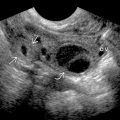TERMINOLOGY
Definitions
- •
Peritoneal cavity: Potential space in abdomen between visceral and parietal peritoneum, usually containing only small amount of peritoneal fluid (for lubrication)
- •
Abdominal cavity: Not synonymous with peritoneal cavity
- ○
Contains all of abdominal viscera (intra- and retroperitoneal)
- ○
Limited by abdominal wall muscles, diaphragm, and (arbitrarily) pelvic brim
- ○
GROSS ANATOMY
Divisions
- •
Greater sac of peritoneal cavity
- •
Lesser sac (omental bursa)
- ○
Communicates with greater sac via epiploic foramen (of Winslow)
- ○
Bounded anteriorly by caudate lobe, stomach, and greater omentum
- –
Posteriorly by pancreas, left adrenal, and kidney
- –
On left by splenorenal and gastrosplenic ligaments
- –
On right by epiploic foramen and lesser omentum
- –
- ○
Compartments
- •
Supramesocolic space
- ○
Divided into right and left supramesocolic spaces, which are separated by falciform ligament
- –
Right supramesocolic space: Composed of right subphrenic space, right subhepatic space, and lesser sac
- –
Left supramesocolic space: Divided into left perihepatic spaces (anterior and posterior) and left subphrenic (anterior perigastric and posterior perisplenic)
- –
- ○
- •
Inframesocolic compartment
- ○
Divided into right inframesocolic space, left inframesocolic space, paracolic gutters, and pelvic cavity
- ○
Pelvic cavity is most dependent part of peritoneal cavity in erect and supine positions
- ○
Peritoneum
- •
Thin serous membrane consisting of single layer of squamous epithelium (mesothelium)
- ○
Parietal peritoneum lines abdominal wall
- ○
Visceral peritoneum (serosa) lines abdominal organs
- ○
Mesentery
- •
Double layer of peritoneum that encloses organ and connects it to abdominal wall
- •
Covered on both sides by mesothelium and has core of loose connective tissue containing fat, lymph nodes, blood vessels, and nerves passing to and from viscera
- •
Most mobile parts of intestine have mesentery, while ascending and descending colon are considered retroperitoneal (covered only by peritoneum on anterior surface)
- •
Root of mesentery is its attachment to posterior abdominal wall
- •
Root of small bowel mesentery is ~ 15 cm and passes from left side of L2 vertebra downward and to right
- ○
Contains superior mesenteric vessels, nerves, and lymphatics
- ○
- •
Transverse mesocolon crosses almost horizontally in front of pancreas, duodenum, and right kidney
Omentum
- •
Multilayered fold of peritoneum that extends from stomach to adjacent organs
- •
Lesser omentum joins lesser curve of stomach and proximal duodenum to liver
- ○
Hepatogastric and hepatoduodenal ligament components contain common bile duct, hepatic and gastric vessels, and portal vein
- ○
- •
Greater omentum
- ○
4-layered fold of peritoneum hanging from greater curve of stomach like apron, covering transverse colon and much of small intestine
- –
Contains variable amounts of fat and abundant lymph nodes
- –
Mobile and can fill gaps between viscera
- –
Acts as barrier to generalized spread of intraperitoneal infection or tumor
- –
- ○
Ligaments
- •
All double-layered folds of peritoneum, other than mesentery and omentum, are peritoneal ligaments
- •
Connect 1 viscus to another (e.g., splenorenal ligament) or viscus to abdominal wall (e.g., falciform ligament)
- •
Contain blood vessels or remnants of fetal vessels
Folds
- •
Reflections of peritoneum with defined borders, often lifting peritoneum off abdominal wall (e.g., median umbilical fold covers urachus and extends from dome of urinary bladder to umbilicus)
Peritoneal Recesses
- •
Dependent pouches formed by peritoneal reflections
- •
Many have eponyms [e.g., Morison pouch for posterior subhepatic (hepatorenal) recess; pouch of Douglas for rectouterine recess]
ANATOMY IMAGING ISSUES
Imaging Recommendations
- •
Transducer: Typically 2-5 MHz for abdominal survey and deep recesses, up to 9 MHz for thinner patients
- •
High-frequency linear transducer 8-15 MHz may be used to evaluate anterior abdominal wall and parietal peritoneum
- •
Patient examined supine with additional decubitus positions to determine if fluid collection is free or loculated
- •
Peritoneal cavity and its various mesenteries and recesses are usually not apparent on imaging studies unless distended or outlined by intraperitoneal fluid or air
PERITONEAL CAVITY










